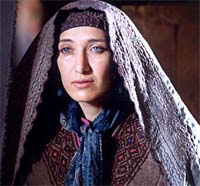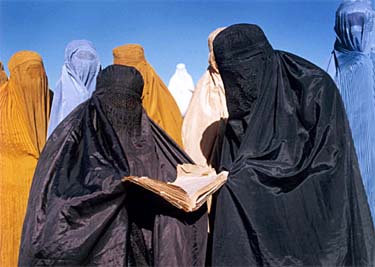 |


|
|
|
|
Film Review by John Demetry
 American audiences may strain for entrance into Iranian filmmaker Mohsen
Makhmalbaf's singular vision. However, Kandahar offers a subtle moment
that resonates to the core of the pop experience. American audiences may strain for entrance into Iranian filmmaker Mohsen
Makhmalbaf's singular vision. However, Kandahar offers a subtle moment
that resonates to the core of the pop experience.
The heroine of the film is Nafas, a journalist returning to save her sister from suicide in Kandahar. She witnesses a group of young girls and their mothers painting their nails beneath their burkas. Nafas makes a note to her sister on her tape recorder: "Remember how you used to wear the color purple on your nails?" This tribute to Steven Spielberg's and Alice Walker's versions of The Color Purple constitutes a brave, radical solidarity. Makhmalbaf claims a unity between the oppressed women (and men) of Afghanistan and Iran with the Queer, feminist, and Black issues addressed in both the film and novel of The Color Purple. He also finds a compatriot in the Jewish Hollywood filmmaker, Spielberg. White heterosexuals take the luxury of Hollywood filmmaking for granted - like nail polish. With The Color Purple, Spielberg engaged the popular audience in the story of a Black lesbian. A real Dream Factory, his most awesome spectacle united the experiences of one sister in the Black South with the experiences of another in Africa.

Makhmalbaf's daunting artsy storytelling - a near-surrealistic documentary technique - achieves such Spielbergian awe with this reference to "The Color Purple". He discovers a universal insight in the subjective experience of a liberated woman daring to return to oppression. This one moment changes the way the spectator experiences each moment of Kandahar. Enabling entrance, there's no recourse for escape. Cutting from the bone-white sand of the desert to the flame-white sun and sky, Makhmalbaf creates a poetic terrain as infinite as the landscape of a dream. Nafas' journey across the desert is a race against the heavens. When the final eclipse of the twentieth century occurs, her sister will commit suicide - the greatest sin in Muslim doctrine. Nafas discovers the purpose of her journey and the meaning behind her encounters. She shares her discovery with her sister through her tape recorder: "So I could bring hope for you from their dreams." It's suggested that her sister will never hear these recordings, but the movie audience does. The audience discovers hope because Makhmalbaf turns these dreams into cinema.
Makhmalbaf records rows of young girls preparing for a journey to Iran. An instructor tells them: "One day, the world will see your troubles and come to your aid." The girls receive a lesson in avoiding landmines with toy dolls strewn on the ground as models. One of the girls sits apart from the lesson and begins rhythmically beating her burka like a drum. Later, at a school where boys - only boys go to school in Afghanistan - learn the Quran, Makhmalbaf choreographs a lesson. The boys recite the "Koran" in unison, their bodies bowing up and down. The teacher singles boys out and asks them to display their knowledge of weapons. One of the boys' show-and-tell: "A semi-automatic weapon." Another boy, named Khak, is expelled when he fails to properly recite the Quran. He delivers, instead, a sing-song vocalization. These two sequences are Makhmalbaf's imaginative ways of allowing the world to see the troubles in Afghanistan. He shares Nafas' journalistic and analytical impulses. Makhmalbaf details the process and the circumstance of oppression. The expressive urges of the girl and the boy - like Spielberg's evocations of children's imaginative lives - reveals human resistance against oppression.
 Makhmalbaf's expressiveness illuminates an emotional understanding. A group
of one-legged men - victims of landmines - race through the desert towards
prosthetic legs parachuting down. Makhmalbaf shoots the sequence in lyrical
slow motion. The rhythmic movement of the men conducts M.R. Davishi's music
score. That music enters the space of the movie audience. The spectacle on
the screen becomes the spectacle of the audience's lives.
Makhmalbaf's expressiveness illuminates an emotional understanding. A group
of one-legged men - victims of landmines - race through the desert towards
prosthetic legs parachuting down. Makhmalbaf shoots the sequence in lyrical
slow motion. The rhythmic movement of the men conducts M.R. Davishi's music
score. That music enters the space of the movie audience. The spectacle on
the screen becomes the spectacle of the audience's lives.
"The search for God was helping these people heal their pains," explains an African-American of his reasons for posing as a doctor in Afghanistan. He came to Afghanistan to help fight dictatorship ofly to find political chaos. Giving a private recitation into Nafas' tape recorder, he also locates the chaos in himself. He questions the place of romantic love in political righteousness. "Can young girls still fall in love with these songs?" ponders Nafas while listening to a song sung by Khak, who acts as a guide for part of her journey. Like Spielberg, Makhmalbaf establishes audience relationship to pop emotions as one of imaginative faith. Sharing the emotions expressed in pop love songs is marked as a freedom to cherish. The second-to-last shot of the film shows the sun setting through the grid of Nafas' veil - a premonition of the eclipse that will signify her sister's suicide. As the reverse angle of the second shot of the film, it reveals all of Kandahar as Nafas' personal experience. The movie is to the spectator's eyes as the moon is to the sun. The diverse audience now totally shares Nafas' point of view - as trapped as Nafas herself. Her final message to her sister: "Only for you." It offers a vision of freedom as a cruel transgression. That shot is a total eclipse of the art - and of the heart. |

© 1997-2002 BEI